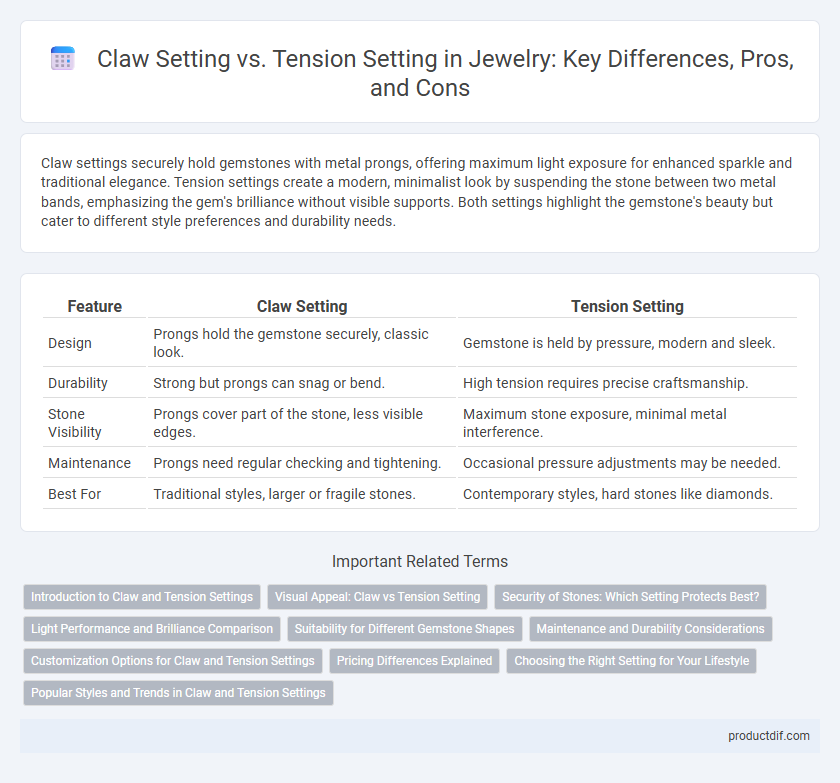Claw settings securely hold gemstones with metal prongs, offering maximum light exposure for enhanced sparkle and traditional elegance. Tension settings create a modern, minimalist look by suspending the stone between two metal bands, emphasizing the gem's brilliance without visible supports. Both settings highlight the gemstone's beauty but cater to different style preferences and durability needs.
Table of Comparison
| Feature | Claw Setting | Tension Setting |
|---|---|---|
| Design | Prongs hold the gemstone securely, classic look. | Gemstone is held by pressure, modern and sleek. |
| Durability | Strong but prongs can snag or bend. | High tension requires precise craftsmanship. |
| Stone Visibility | Prongs cover part of the stone, less visible edges. | Maximum stone exposure, minimal metal interference. |
| Maintenance | Prongs need regular checking and tightening. | Occasional pressure adjustments may be needed. |
| Best For | Traditional styles, larger or fragile stones. | Contemporary styles, hard stones like diamonds. |
Introduction to Claw and Tension Settings
Claw settings, also known as prong settings, securely hold gemstones with metal projections that grip the stone, maximizing light exposure for enhanced brilliance. Tension settings use the metal band's pressure to suspend the gemstone, creating a modern, floating appearance with minimal metal interference. Both settings offer distinct aesthetic and functional advantages, catering to different design preferences and durability requirements in jewelry.
Visual Appeal: Claw vs Tension Setting
Claw settings showcase gemstones with elevated prongs, creating maximum light exposure and a classic, detailed appearance that enhances brilliance and sparkle. Tension settings hold the stone in place through pressure, producing a sleek, modern floating effect with minimal metal visible, emphasizing the gem's size and clarity. Visual appeal varies as claw settings highlight intricate metalwork while tension settings offer a contemporary, minimalist aesthetic.
Security of Stones: Which Setting Protects Best?
Claw settings secure stones with multiple metal prongs gripping the gem tightly, offering reliable protection against impacts and enhancing durability. Tension settings hold stones in place through pressure between two metal bands, providing a sleek appearance but potentially exposing edges to more risk of chips or loosening over time. For maximum security, claw settings are generally favored for safeguarding valuable or softer gemstones prone to damage.
Light Performance and Brilliance Comparison
Claw settings elevate gemstones, allowing maximum light to enter from various angles, enhancing brilliance and sparkle. Tension settings secure the stone with pressure, creating minimal metal coverage that maximizes light exposure and results in a modern, radiant glow. Both settings optimize light performance differently, with claw settings emphasizing multidirectional brilliance and tension settings highlighting edge-to-edge luminosity.
Suitability for Different Gemstone Shapes
Claw settings are highly versatile, securely holding various gemstone shapes such as round, oval, princess, and emerald cuts by using prongs that grip the stone from multiple angles. Tension settings best suit harder gemstones like diamonds and sapphires with round or square cuts, as the stone is held in place by pressure, creating a floating effect that requires durable materials. Choosing between claw and tension settings depends on the gemstone's durability and shape, ensuring optimal security and aesthetic appeal.
Maintenance and Durability Considerations
Claw settings require regular inspection to ensure prongs remain tight and secure, as they can snag or bend, potentially risking stone loss. Tension settings rely on metal pressure to hold the gemstone, demanding precise craftsmanship and occasional professional checks to maintain optimal grip and prevent loosening. Both settings benefit from routine cleaning, but tension settings generally offer enhanced durability due to fewer exposed components vulnerable to damage.
Customization Options for Claw and Tension Settings
Claw settings offer extensive customization options, including varied prong shapes, sizes, and metal types to securely hold gemstones while enhancing their brilliance. Tension settings provide sleek, modern customization through precise metal band designs that create the illusion of a floating stone, with adjustments in band thickness and finish for a unique look. Both settings allow for tailored personalization to match individual style preferences and gemstone characteristics.
Pricing Differences Explained
Claw settings generally have lower manufacturing costs due to simpler craftsmanship and less material usage, making them more affordable than tension settings. Tension settings require precise engineering and stronger metals to securely hold the gemstone, increasing labor and materials expenses that elevate the overall price. Consumers often pay a premium for tension settings because of their modern aesthetic and the complexity involved in ensuring durability and stone security.
Choosing the Right Setting for Your Lifestyle
Claw settings provide robust security for active lifestyles by firmly holding gemstones with metal prongs, making them ideal for everyday wear and durability. Tension settings, while sleek and modern, offer a more delicate hold that suits those seeking a contemporary look with less exposure to physical activities. Selecting between claw and tension settings depends on balancing personal style preferences with the level of protection needed based on daily routines and activity levels.
Popular Styles and Trends in Claw and Tension Settings
Claw settings remain a popular choice in jewelry for their classic, secure hold and ability to elevate gemstones, especially in engagement rings where solitaire styles dominate. Tension settings have gained traction in contemporary designs, favored for their modern, sleek appearance and the illusion of floating stones, appealing particularly to those seeking minimalist aesthetics. Both settings continue to influence trends, with claw settings offering timeless elegance and tension settings attracting avant-garde enthusiasts in the jewelry market.
Claw Setting vs Tension Setting Infographic

 productdif.com
productdif.com